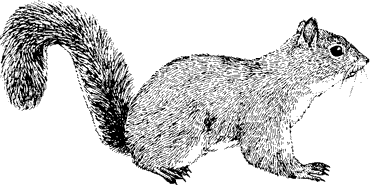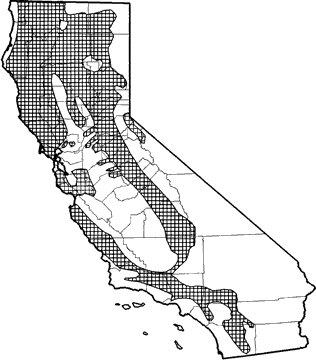
Western Gray Squirrel
Distribution, Abundance, and Seasonality
Fairly common locally in mature stands of most conifer, hardwood, and mixed hardwood-conifer habitats in the Klamath, Cascade, Transverse, Peninsular, and Sierra Nevada Ranges (Ingles 1965). Also found in the Sacramento Valley in riparian stands, and in other suitable habitats.

Range Map
Specific Habitat Requirements
Feeding: Opportunistic feeders. Diet varies with the availability of seasonal and local foods. They eat hypogeous fungi, pine nuts, acorns, fruits of California bay, other fruits and nuts, forbs, and other tender shoots and leaves (Steinecker and Browning 1970, Steinecker 1977). Fungi are important spring and summer foods, and acorns, when available, are very important summer, fall, and winter foods. Gray squirrels bury nuts singly 8-10 cm (3-4 in) deep (scatter-hoard), and then dig them up to eat in the winter. They locate these nuts, and hypogeous fungi, with their keen sense of smell, although deep snow hampers this ability.
Cover: Use mature tree stands for cover. Require cavities in trees and snags for nests.
Reproduction: In winter, make brood nests in tree and snag cavities, often enlarging an abandoned woodpecker cavity. They also build nests on branches of oak, fir, or pine trees. Nests are lined with shredded bark, grass, moss, and lichen.
Water: Have been observed lapping water from cavities and streams.
Pattern: These squirrels are dependent upon mature stands of mixed conifer and oak habitats. Closely associated with oaks. Require large trees, mast, and snags.
Species Life History
Activity Patterns: Yearlong diurnal activity; most active in early morning and late afternoon (Maser et al. 1981).
Seasonal Movements / Migration: Non-migratory.
Home Range: Home range in the Sierra Nevada foothills varied from 0.2 to 0.7 ha (0.5 to 1.8 ac) for females, and from 0.5 to 1.0 ha (1.2 to 2.5 ac) for males (Ingles 1947). Home ranges of males overlapped considerably.
Territory: In Butte Co., territories averaged 1 /4 to 1/ 3 the size of home ranges (Ingles 1947). Lactating females defended territories of 0.1 to 0.3 ha (0.3 to 0.8 ac)
Reproduction: Breed from January through September, with most births occurring March into June. Gestation period 43-44 days; 1 litter/yr. Average litter size 3-4 (range 1-5).
Niche: Potential predators include coyotes, foxes, bobcats, martens, and large hawks and owls. Heavy snowfall covers stores of buried food, and increases predation pressure. May damage commercial fruit and nut crops. Local populations occasionally decimated by disease. Numbers have been reduced by removal of snags, duff, slash, or oak trees.
Sources & References
California Department of Fish and Game, 1999.
California's Wildlife, Sacramento, CA.
Written by: T. Harvey, reviewed by: M. White, edited by: M. White, C. Polite
Asserson, W. C. III, 1974. Western gray squirrel study in Kern County, California. Calif. Dept. Fish and Game, Wildl. Manage. Branch Admin. Rep. No.74-1. 32pp. Ingles, L. G. 1947. Ecology and life history of the California gray squirrel. Calif. Fish and Game 33:138-158. Ingles, L. G. 1965. Mammals of the Pacific states. Stanford Univ. Press, Stanford, CA. 506pp. Maser, C., B. R. Mate, J. F. Franklin, and C. T. Dyrness. 1981. Natural history of Oregon coast mammals. Pac. Northwest For. And Range Exp. Sta., USDA, For. Serv., Gen. Tech. Rep., PNW-133. 496pp. Steinecker, W. E. 1977. Supplemental data on the food habits of the western gray squirrel. Calif. Fish and Game 63:11-21. Steinecker, W. E., and B. M. Browning. 1970. Food habits of the western gray squirrel. Calif. Fish and Game 56:36-48.
California Animal Facts | California's Wildlife